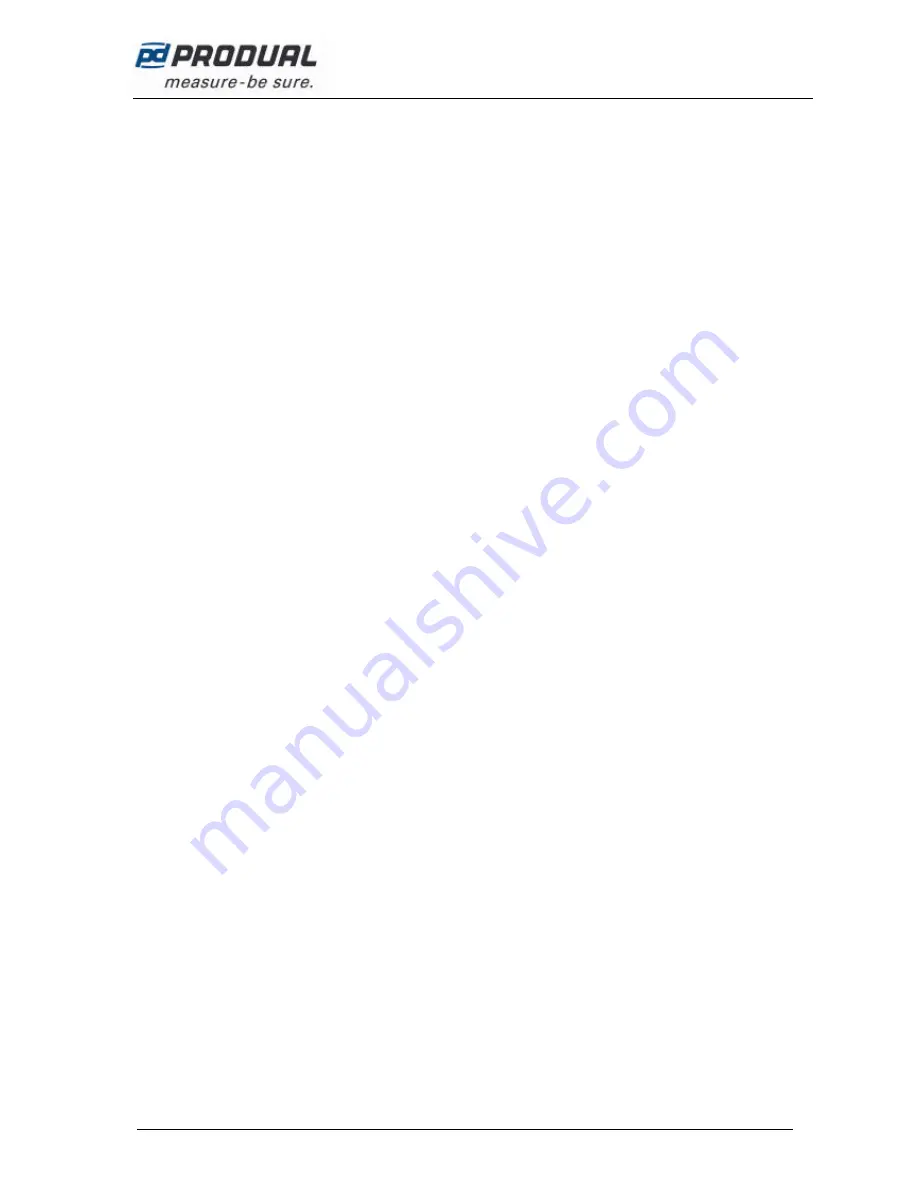
1150.11E
January 2007
www.produal.fi
Enquiries: T:
05 230 9200
F:
05 230 9210
Copyright
2005 Produal Oy. All rights reserved
Products meet the requirements of directive 89/336/EEC and standards EN50081-1: 1992 (Emission) and EN50082-2: 1995 (Immunity).
NIGHT MODE
The configuration parameter J7 sets the controller operation during the night time; Relaxed Deadzone or
Frost Protection (Thermostat).
1) Relaxed Deadzone at Night
The controller operates as in the DAY mode but the deadzone around the controller is expanded to NDz
value. Therefore at the night time the controller energy consumption is reduced.
NOTE: It is also possible to set the night deadzone to smaller value than day deadzone.
2) Frost Protection (Thermostat)
In the NIGHT mode the controller controls to the NIGHT/FROST setpoint. If the temperature falls below the
NIGHT setpoint (5..20°C), the heating valve is opened and the fan is overridden on (if fan speed control has
been enabled). The NIGHT setpoint is adjustable via Modbus network or in the configuration mode. If the
temperature exceeds 2°C the NIGHT setpoint the heating valve is closed and the fan is switched off.
Fan Speed Control
Fan speed control can be enabled during the commissioning (configuration parameter FAN). When fan
speed control is enabled the Heating Analogue output is converted operate as the control signal to the
FCRY3 fan speed control relay module.
In automatic control the fan speed output operates as follows:-
-
Valves closed
à
Fan speed output 0%
-
Heating/Cooling Valve Opens
à
Fan speed output is set to 3.3V (Speed 1)
-
Heating/Cooling Valve Opens more than 25%
à
speed output is set to 6.6V (Speed 2)
-
Heating/Cooling Valve Opens more than 50%
à
speed output is set to 10V (Speed 3)
Automatic Speed 3 control is disabled as default. However, the user can manually override speed 3 on
through the keypad. Typically speed 3 causes a higher level fan noise and therefore it is recommended that
this is manual override option operated by the user. Automatic Speed 3 control can be enabled during the
commissioning via basic settings.
When the controller switches to NIGHT mode or the temperature is within the dead zone, the fan is
automatically switched OFF after 5 minutes timeout.
Ventilation Boost
(CO2 Control)
If HDK or HDH CO2 transmitter is connected to the controller analogue input U1, the controller can be
enabled to boost the fan speed / switch the fan On in case of high CO2 content in the occupancy space. This
is a very useful feature to provide demand based ventilation. High CO2 level overrides the fan speed set by
the temperature based fan speed control.
Day Extension via digital
input
The controller has hardware digital input that can be connected to a momentary push button contact (e.g.
PJP1) or to a PIR sensor (e.g. LA24) to override the controller to DAY operation. These are ty pically used
out of hours to provide comfort control. Alternatively PIR input can be used as the primary means of
switching between DAY and NIGHT modes. The digital input is normally closed.
NOTE: The digital input is activated when it is first time closed. The controller is supplied with the digital input
as open contact.
Day Extension via
keypad
The controller can be overridden to DAY operation by pressing the “MAN IN THE HOUSE” occupancy
button. When pressed the controller is overridden to DAY mode for the period of two hours. The extension
time is adjustable between 1..480 minutes via Modbus network.
VAV Control with Fresh
Air Demand Boost
The controller can also be used as Variable Air Volume controller by connecting the VAV Box damper to the
output Y1. The output Y1 is then modulated according to temperature demand in the room space.
If HDK or HDH CO2 transmitter is connected to the controller analogue input U1, the controller can increase
the fresh air demand i.e. overdrive the analogue output Y1 when the CO2 content in the room space
exceeds the acceptable limit. The CO2 influence is set via configuration parameters CO2 LO (e.g. 750 ppm)
and CO2 HI (e.g. 1250 ppm). Between the CO2 limits the influence is calculated using linear relationship i.e.
when CO2 measurement is at CO2 HI setpoint, the CO2 influence is 100% (Y1=10V).
Air-side application
Air side application controls the temperature by modulating the damper output and 3-point control outputs.
When the room temperature is at the setpoint the control output is at 50%. When the temperature increases
above the setpoint the control signal starts to drop providing cooling to the room space. When the
temperature drops below the setpoint the control output increases to provide heating to the room space.
For the air-side application to operate correctly set configuration parameters J1 and J2 to Direct Operation.

























